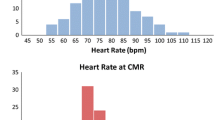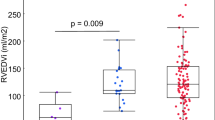Abstract
Pulmonary valve replacement (PVR) in patients with repaired tetralogy of Fallot (rTOF-TAP) is often based on cardiac MRI (CMR) right ventricular (RV) volumes indexed to body surface area (BSA). Weight extremes result in increased patient morbidity and affect indexed measurements. We hypothesized that patients with rTOF-TAP at extremes of weight have (1) over- or underestimated indexed volumes and (2) altered parameters of cardiac function. CMRs in patients with rTOF-TAP were retrospectively reviewed; analysis included right and left ventricular (LV) volumes and ejection fractions (EF) and peak global LV circumferential strain (ε cc) from myocardial tagged images. Indexed volumes were recalculated using ideal BSA. Weight categories were assigned: underweight, appropriate weight, overweight, and obese. Linear regression models with weight category, spline of age, and gender were created to assess the association of weight and parameters of volume and function. When RV volumes were corrected for ideal BSA, 11 (31%) additional overweight and obese patients met published criteria for PVR and 3 (38%) underweight patients no longer met criteria. Obese and overweight patients had larger absolute LV and RV diastolic volumes, but no difference in volumes indexed to ideal BSA. Modeling demonstrated no difference in LVEF or RVEF by weight categories but significant differences in global LV ε cc. Extremes of body weight may result in inappropriate timing of PVR. Extremes of weight lead to abnormalities in global LV ε cc. Although clinical implications of abnormal ε cc are unclear, these patients may be at higher risk for early ventricular dysfunction.


Similar content being viewed by others
References
Hoffman JI, Kaplan S (2002) The incidence of congenital heart disease. J Am Coll Cardiol 39(12):1890–1900
Geva T (2011) Repaired tetralogy of Fallot: the roles of cardiovascular magnetic resonance in evaluating pathophysiology and for pulmonary valve replacement decision support. J Cardiovasc Magn Reson 13:9. https://doi.org/10.1186/1532-429X-13-9
Murphy JG, Gersh BJ, Mair DD, Fuster V, McGoon MD, Ilstrup DM, McGoon DC, Kirklin JW, Danielson GK (1993) Long-term outcome in patients undergoing surgical repair of tetralogy of Fallot. N Engl J Med 329(9):593–599. https://doi.org/10.1056/NEJM199308263290901
Quail MA, Frigiola A, Giardini A, Muthurangu V, Hughes M, Lurz P, Khambadkone S, Deanfield JE, Tsang V, Taylor AM (2012) Impact of pulmonary valve replacement in tetralogy of Fallot with pulmonary regurgitation: a comparison of intervention and nonintervention. Ann Thorac Surg 94(5):1619–1626. https://doi.org/10.1016/j.athoracsur.2012.06.062
Oosterhof T, van Straten A, Vliegen HW, Meijboom FJ, van Dijk AP, Spijkerboer AM, Bouma BJ, Zwinderman AH, Hazekamp MG, de Roos A, Mulder BJ (2007) Preoperative thresholds for pulmonary valve replacement in patients with corrected tetralogy of Fallot using cardiovascular magnetic resonance. Circulation 116(5):545–551. https://doi.org/10.1161/CIRCULATIONAHA.106.659664
Geva T (2006) Indications and timing of pulmonary valve replacement after tetralogy of Fallot repair. Semin Thorac Cardiovasc Surg. https://doi.org/10.1053/j.pcsu.2006.02.009
Frigiola A, Tsang V, Bull C, Coats L, Khambadkone S, Derrick G, Mist B, Walker F, van Doorn C, Bonhoeffer P, Taylor AM (2008) Biventricular response after pulmonary valve replacement for right ventricular outflow tract dysfunction: is age a predictor of outcome? Circulation 118(14 Suppl):S182–S190. https://doi.org/10.1161/CIRCULATIONAHA.107.756825
Therrien J, Provost Y, Merchant N, Williams W, Colman J, Webb G (2005) Optimal timing for pulmonary valve replacement in adults after tetralogy of Fallot repair. Am J Cardiol 95(6):779–782. https://doi.org/10.1016/j.amjcard.2004.11.037
Lee C, Kim YM, Lee CH, Kwak JG, Park CS, Song JY, Shim WS, Choi EY, Lee SY, Baek JS (2012) Outcomes of pulmonary valve replacement in 170 patients with chronic pulmonary regurgitation after relief of right ventricular outflow tract obstruction: implications for optimal timing of pulmonary valve replacement. J Am Coll Cardiol 60(11):1005–1014. https://doi.org/10.1016/j.jacc.2012.03.077
Geva T (2014) Is MRI the preferred method for evaluating right ventricular size and function in patients with congenital heart disease? MRI is the preferred method for evaluating right ventricular size and function in patients with congenital heart disease. Circ Cardiovasc Imaging 7(1):190–197. https://doi.org/10.1161/CIRCIMAGING.113.000553
Geva T (2013) Indications for pulmonary valve replacement in repaired tetralogy of fallot: the quest continues. Circulation 128(17):1855–1857. https://doi.org/10.1161/CIRCULATIONAHA.113.005878
Geva T, Gauvreau K, Powell AJ, Cecchin F, Rhodes J, Geva J, del Nido P (2010) Randomized trial of pulmonary valve replacement with and without right ventricular remodeling surgery. Circulation 122(11 Suppl):S201–S208. https://doi.org/10.1161/CIRCULATIONAHA.110.951178
Chang SA, Choe YH, Jang SY, Kim SM, Lee SC, Oh JK (2012) Assessment of left and right ventricular parameters in healthy Korean volunteers using cardiac magnetic resonance imaging: change in ventricular volume and function based on age, gender and body surface area. Int J Cardiovasc Imaging 28(Suppl 2):141–147. https://doi.org/10.1007/s10554-012-0150-1
Maskatia SA, Spinner JA, Nutting AC, Slesnick TC, Krishnamurthy R, Morris SA (2013) Impact of obesity on ventricular size and function in children, adolescents and adults with Tetralogy of Fallot after initial repair. Am J Cardiol 112(4):594–598. https://doi.org/10.1016/j.amjcard.2013.04.030
Pinto NM, Marino BS, Wernovsky G, de Ferranti SD, Walsh AZ, Laronde M, Hyland K, Dunn SO Jr, Cohen MS (2007) Obesity is a common comorbidity in children with congenital and acquired heart disease. Pediatrics 120(5):e1157–e1164. https://doi.org/10.1542/peds.2007-0306
Shustak RJ, McGuire SB, October TW, Phoon CK, Chun AJ (2012) Prevalence of obesity among patients with congenital and acquired heart disease. Pediatr Cardiol 33(1):8–14. https://doi.org/10.1007/s00246-011-0049-y
Chinali M, de Simone G, Roman MJ, Lee ET, Best LG, Howard BV, Devereux RB (2006) Impact of obesity on cardiac geometry and function in a population of adolescents: the Strong Heart Study. J Am Coll Cardiol 47(11):2267–2273. https://doi.org/10.1016/j.jacc.2006.03.004
Heckbert SR, Post W, Pearson GD, Arnett DK, Gomes AS, Jerosch-Herold M, Hundley WG, Lima JA, Bluemke DA (2006) Traditional cardiovascular risk factors in relation to left ventricular mass, volume, and systolic function by cardiac magnetic resonance imaging: the Multiethnic Study of Atherosclerosis. J Am Coll Cardiol 48(11):2285–2292. https://doi.org/10.1016/j.jacc.2006.03.072
Cao J, Peng L, Li R, Chen Y, Li X, Mo B, Li X (2014) Nutritional risk screening and its clinical significance in hospitalized children. Clin Nutr 33(3):432–436. https://doi.org/10.1016/j.clnu.2013.06.009
Egbe AC, Mittnacht AJ, Nguyen K, Joashi U (2014) Risk factors for morbidity in infants undergoing tetralogy of fallot repair. Ann Pediatr Cardiol 7(1):13–18. https://doi.org/10.4103/0974-2069.126539
Kirsch RE, Glatz AC, Gaynor JW, Nicolson SC, Spray TL, Wernovsky G, Bird GL (2014) Results of elective repair at 6 months or younger in 277 patients with tetralogy of Fallot: a 14-year experience at a single center. J Thorac Cardiovasc Surg 147(2):713–717. https://doi.org/10.1016/j.jtcvs.2013.03.033
Eskedal LT, Hagemo PS, Seem E, Eskild A, Cvancarova M, Seiler S, Thaulow E (2008) Impaired weight gain predicts risk of late death after surgery for congenital heart defects. Arch Dis Child 93(6):495–501. https://doi.org/10.1136/adc.2007.126219
Sharma A, Vallakati A, Einstein AJ, Lavie CJ, Arbab-Zadeh A, Lopez-Jimenez F, Mukherjee D, Lichstein E (2014) Relationship of body mass index with total mortality, cardiovascular mortality, and myocardial infarction after coronary revascularization: evidence from a meta-analysis. Mayo Clin Proc 89(8):1080–1100. https://doi.org/10.1016/j.mayocp.2014.04.020
Thornqvist C, Gislason GH, Kober L, Jensen PF, Torp-Pedersen C, Andersson C (2014) Body mass index and risk of perioperative cardiovascular adverse events and mortality in 34,744 Danish patients undergoing hip or knee replacement. Acta Orthop 85(5):456–462. https://doi.org/10.3109/17453674.2014.934184
Clinical guidelines on the identification, evaluation, and treatment of overweight and obesity in adults: executive summary. Expert panel on the identification, evaluation, and treatment of overweight in adults (1998). Am J Clin Nutr 68(4):899–917
Devine BJ (1974) Gentamicin therapy. Drug Intel Clin Phar 8(11):650–655
Phillips S, Edlbeck A, Kirby M, Goday P (2007) Ideal body weight in children. Nutr Clin Pract 22(2):240–245. https://doi.org/10.1177/0115426507022002240
Haycock GB, Schwartz GJ, Wisotsky DH (1978) Geometric method for measuring body surface area: a height-weight formula validated in infants, children, and adults. J Pediatr 93(1):62–66
Schulz-Menger J, Bluemke DA, Bremerich J, Flamm SD, Fogel MA, Friedrich MG, Kim RJ, von Knobelsdorff-Brenkenhoff F, Kramer CM, Pennell DJ, Plein S, Nagel E (2013) Standardized image interpretation and post processing in cardiovascular magnetic resonance: Society for Cardiovascular Magnetic Resonance (SCMR) Board of Trustees Task Force on Standardized Post Processing. J Cardiovasc Magn Reson 15(1):35. https://doi.org/10.1186/1532-429X-15-35
Cerqueira MD, Weissman NJ, Dilsizian V, Jacobs AK, Kaul S, Laskey WK, Pennell DJ, Rumberger JA, Ryan T, Verani MS, American Heart Association Writing Group on Myocardial S, Registration for Cardiac I (2002) Standardized myocardial segmentation and nomenclature for tomographic imaging of the heart. A statement for healthcare professionals from the Cardiac Imaging Committee of the Council on Clinical Cardiology of the American Heart Association. Circulation 105(4):539–542
Khalaf A, Tani D, Tadros S, Madan S (2013) Right- and left-ventricular strain evaluation in repaired pediatric Tetralogy of Fallot patients using magnetic resonance tagging. Pediatr Cardiol 34(5):1206–1211. https://doi.org/10.1007/s00246-013-0631-6
Harris PA, Taylor R, Thielke R, Payne J, Gonzalez N, Conde JG (2009) Research electronic data capture (REDCap)—a metadata-driven methodology and workflow process for providing translational research informatics support. J Biomed Inform 42(2):377–381. https://doi.org/10.1016/j.jbi.2008.08.010
Black D, Bryant J, Peebles C, Davies L, Inskip H, Godfrey K, Vettukattil J, Hanson M (2014) Increased regional deformation of the left ventricle in normal children with increased body mass index: implications for future cardiovascular health. Pediatr Cardiol 35(2):315–322. https://doi.org/10.1007/s00246-013-0778-1
Rider OJ, Ajufo E, Ali MK, Petersen SE, Nethononda R, Francis JM, Neubauer S (2015) Myocardial tissue phase mapping reveals impaired myocardial tissue velocities in obesity. Int J Cardiovasc Imaging 31(2):339–347. https://doi.org/10.1007/s10554-014-0548-z
Fogel MA, Pawlowski T, Keller MS, Cohen MS, Goldmuntz E, Diaz L, Li C, Whitehead KK, Harris MA (2015) The cardiovascular effects of obesity on ventricular function and mass in patients after tetralogy of fallot repair. J Pediatr 167(2):325–330 e321. https://doi.org/10.1016/j.jpeds.2015.04.018
Briston DA, Sabanayagam A, Zaidi AN (2017) Observations on obesity patterns in tetralogy of Fallot patients from childhood to adulthood. Cardiol Young 27(5):890–894. https://doi.org/10.1017/S1047951116001530
Geva T, Sandweiss BM, Gauvreau K, Lock JE, Powell AJ (2004) Factors associated with impaired clinical status in long-term survivors of tetralogy of Fallot repair evaluated by magnetic resonance imaging. J Am Coll Cardiol 43(6):1068–1074. https://doi.org/10.1016/j.jacc.2003.10.045
Funding
The project was supported by the National Center for Research Resources, Grant UL1 RR024975-01, and is now at the National Center for Advancing Translational Sciences, Grant 2 UL1 TR000445-06 (Bethesda, MD). The content is solely the responsibility of the authors and does not necessarily represent the official views of the NIH. Research reported in this publication was supported by the National Heart, Lung, and Blood Institute of the National Institutes of Health under Award Number K23HL123938 (Bethesda, MD) (Soslow). The content is solely the responsibility of the authors and does not necessarily represent the official views of the National Institutes of Health.
Author information
Authors and Affiliations
Corresponding author
Ethics declarations
Conflict of interest
The authors declare that they have no conflict of interest.
Ethical Approval
All procedures performed in studies involving human participants were in accordance with the ethical standards of the institutional and/or national research committee and with the 1964 Helsinki Declaration and its later amendments or comparable ethical standards.
Rights and permissions
About this article
Cite this article
Simpson, S.A., Field, S.L., Xu, M. et al. Effect of Weight Extremes on Ventricular Volumes and Myocardial Strain in Repaired Tetralogy of Fallot as Measured by CMR. Pediatr Cardiol 39, 575–584 (2018). https://doi.org/10.1007/s00246-017-1793-4
Received:
Accepted:
Published:
Issue Date:
DOI: https://doi.org/10.1007/s00246-017-1793-4




